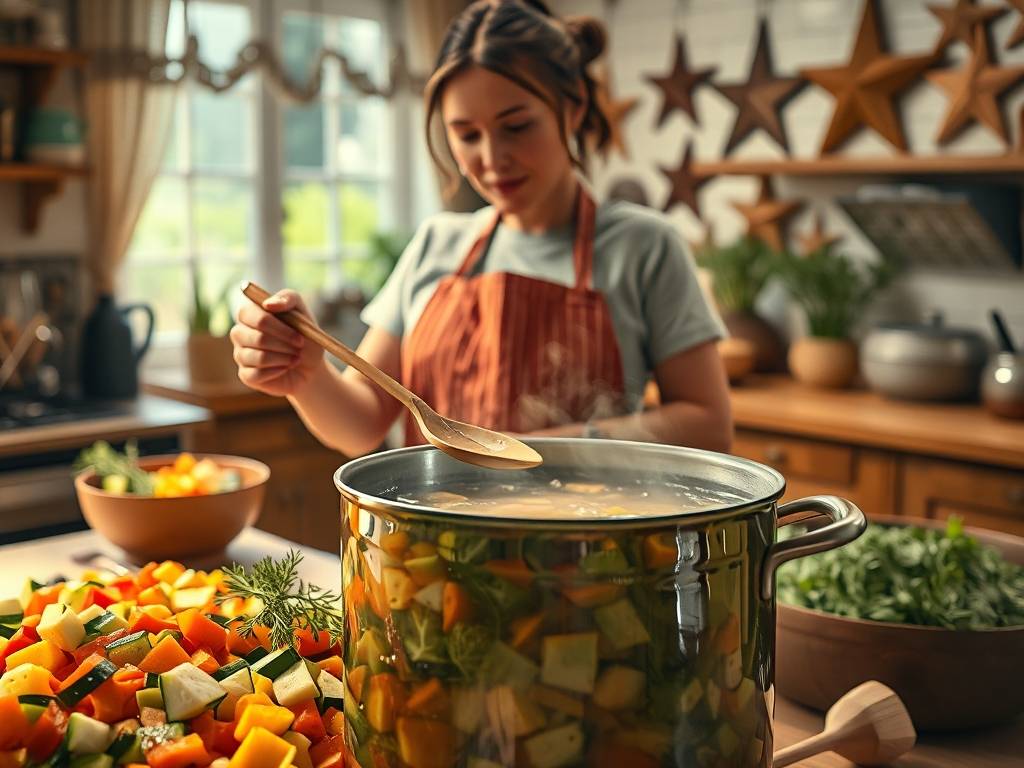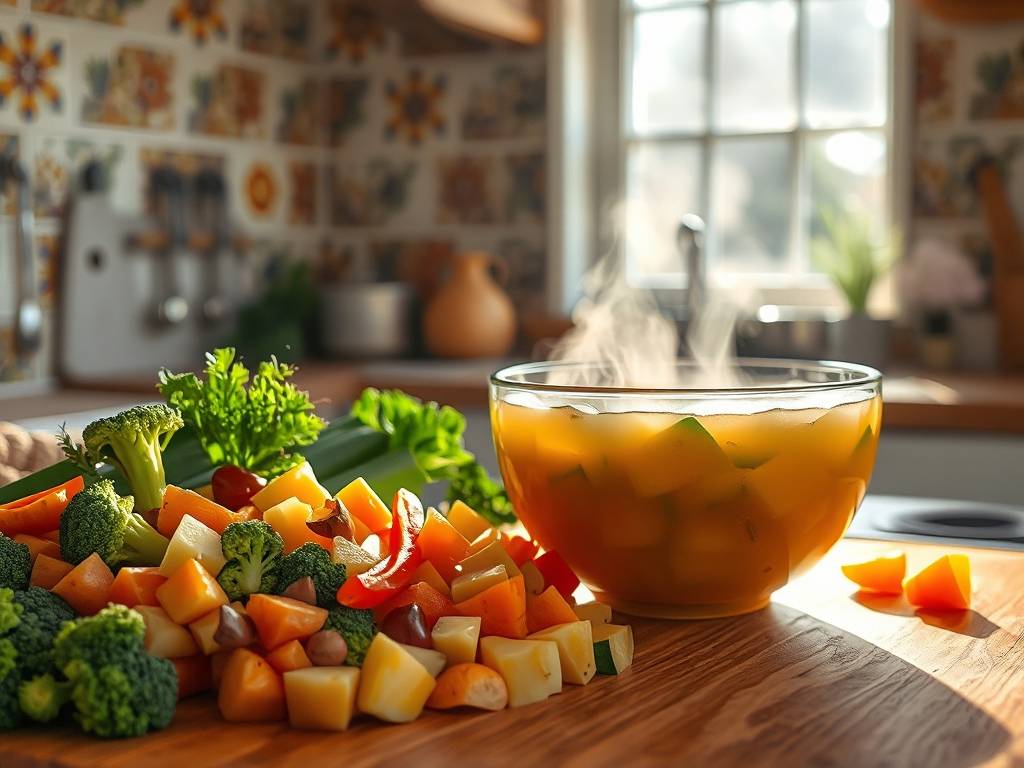How to Make Vegetable Soup: Mixed Veg, Clear Broth, Light & Healthy
Vegetable soup is a timeless classic that transcends cultures and cuisines. It’s a dish that can be both comforting and invigorating, simple yet sophisticated. A well-made vegetable soup with a clear broth is not only light and healthy but also packed with nutrients and flavors. Whether you’re looking for a quick weeknight dinner, a detoxifying meal, or a starter for a dinner party, this recipe will guide you through creating a delicious, wholesome vegetable soup that celebrates the natural goodness of fresh produce.
The Philosophy Behind Clear Broth Vegetable Soup
A clear broth vegetable soup stands out for its simplicity and purity. Unlike creamy or heavily seasoned soups, this version relies on the natural flavors of vegetables, enhanced by a delicate broth. The goal is to create a soup that is light on the palate but deeply satisfying. The clarity of the broth is achieved through careful preparation and cooking techniques, ensuring that the soup remains refreshing and easy to digest.

This type of soup is incredibly versatile. You can use almost any combination of vegetables you have on hand, making it an excellent way to reduce food waste. Additionally, it’s naturally vegan and gluten-free, catering to a wide range of dietary preferences. The key is to balance the flavors and textures of the vegetables so that no single ingredient overpowers the others.

Selecting the Right Ingredients
The foundation of a great vegetable soup lies in the quality of its ingredients. Since the broth is clear and light, each component must be fresh and flavorful. Here’s what you’ll need:
For the Broth:
- 2 liters of water
- 1 large onion, roughly chopped
- 2 carrots, peeled and chopped
- 2 celery stalks, chopped
- 1 leek, cleaned and sliced (white and light green parts only)
- 2 cloves of garlic, smashed
- A small bunch of fresh parsley
- 1 bay leaf
- 5-6 black peppercorns
- Salt to taste
For the Soup:
- 1 tablespoon olive oil
- 1 onion, finely diced
- 2 carrots, peeled and diced
- 2 celery stalks, diced
- 1 zucchini, diced
- 1 cup green beans, trimmed and cut into 1-inch pieces
- 1 cup cauliflower or broccoli florets
- 1 cup spinach or kale, roughly chopped
- Salt and freshly ground black pepper to taste
- Fresh herbs like parsley, dill, or thyme for garnish
- Lemon juice (optional, for serving)
Optional Add-Ins:
- 1 cup canned tomatoes, diced
- ½ cup peas
- ½ cup corn kernels
- 1 potato, diced (for a heartier version)
Step-by-Step Cooking Instructions
Step 1: Prepare the Vegetable Broth
While you can use store-bought vegetable broth, making your own is surprisingly simple and elevates the soup to another level. Homemade broth ensures that your soup is free from additives and allows you to control the flavor profile.
- In a large stockpot, combine the water, roughly chopped onion, carrots, celery, leek, garlic, parsley, bay leaf, and peppercorns.
- Bring to a boil over high heat, then reduce the heat to low and let it simmer uncovered for 30-40 minutes. Skim off any impurities that rise to the surface to keep the broth clear.
- After simmering, strain the broth through a fine-mesh sieve into a clean pot, pressing down on the vegetables to extract all the flavors. Discard the solids. You should have a clear, aromatic broth ready to use. Season with salt to taste.
Step 2: Sauté the Aromatics
The next step is to build layers of flavor by sautéing the aromatics. This process, known as "sweating," helps to release the natural sugars and deepen the flavors without browning the vegetables.
- In a large soup pot, heat the olive oil over medium heat.
- Add the finely diced onion, carrots, and celery. Sauté for 5-7 minutes until the vegetables are softened but not colored. Stir occasionally to prevent sticking.
Step 3: Add the Broth and Vegetables
Now, it’s time to combine the broth with the sautéed vegetables and add the remaining ingredients.
- Pour the prepared vegetable broth into the pot with the sautéed vegetables. Bring to a gentle boil.
- Add the harder vegetables first, such as green beans and cauliflower, as they take longer to cook. Simmer for about 5 minutes.
- Then add the medium-hard vegetables like zucchini and potatoes (if using). Simmer for another 5 minutes.
- Finally, add the soft vegetables like spinach, kale, peas, or corn. These need only a minute or two to cook through.
- If using tomatoes, add them along with the medium-hard vegetables to allow their flavor to meld into the soup.
Step 4: Season and Simmer
Seasoning is crucial for balancing the flavors. Remember that the broth is already seasoned, so taste as you go.
- Add salt and pepper gradually, tasting after each addition.
- Let the soup simmer for another 5-10 minutes until all the vegetables are tender but still retain a bit of crunch. Overcooking can make them mushy and dull the flavors.
- If you prefer a more pronounced herbal note, add a sprig of thyme or rosemary during the last few minutes of cooking.
Step 5: Garnish and Serve
The final touches can make a significant difference in both presentation and taste.
- Remove the soup from heat and discard any herb sprigs used during cooking.
- Stir in freshly chopped parsley, dill, or thyme.
- For a bright, refreshing finish, add a squeeze of lemon juice just before serving. This enhances the flavors and adds a subtle tang.
- Ladle the soup into bowls and serve hot. It pairs wonderfully with crusty whole-grain bread or a simple side salad.
Tips for a Perfect Clear Broth Vegetable Soup
- Keep it Clear: To maintain a clear broth, avoid boiling the soup vigorously after adding the vegetables. A gentle simmer is sufficient.
- Uniform Cutting: Cut the vegetables into similar-sized pieces to ensure even cooking.
- Layering Flavors: Sautéing the aromatics first and adding vegetables in stages based on their cooking times ensures that each ingredient is perfectly cooked.
- Herbs at the End: Adding fresh herbs at the end preserves their vibrant color and flavor.
- Customize Freely: Feel free to experiment with different vegetables, herbs, and spices. For example, add a pinch of turmeric for color and anti-inflammatory benefits, or a dash of cumin for warmth.
The Health Benefits
This vegetable soup is not just delicious; it’s a nutritional powerhouse. Packed with vitamins, minerals, and antioxidants from a variety of vegetables, it supports overall health and well-being. The clear broth is hydrating and easy on the digestive system, making it an excellent choice for those recovering from illness or looking to maintain a light diet. The high fiber content from the vegetables promotes digestive health, while the low calorie count makes it ideal for weight management.
Moreover, this soup is inherently vegan and gluten-free, making it accessible to people with dietary restrictions. It’s also a great way to incorporate more vegetables into your diet, especially for picky eaters.
Conclusion
Making a mixed vegetable soup with a clear broth is an art that celebrates simplicity and freshness. By starting with a homemade broth and carefully selecting and cooking your vegetables, you can create a dish that is both nourishing and delightful. This soup is a testament to the idea that healthy food doesn’t have to be bland or complicated. With its vibrant colors, textures, and flavors, it’s a bowl of comfort that you can feel good about enjoying any day of the week.
So, the next time you’re in need of a light, healthy meal, remember this recipe. Embrace the process, experiment with ingredients, and savor every spoonful of your homemade vegetable soup.






发表评论